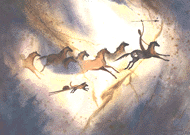History of Fire
A BRIEF HISTORY OF FIRE AND ITS USES - by Ed Semmelroth
Throughout the centuries there has been such an intimate connection of fire with the cultural growth of humanity that whatever relates to the antiquity of fire is important in tracing- the history of early progress.’ And because all inventions make use of what has gone before, the steps, which lead up to the making of the first stoves, are necessary in writing of their history. Logically, of course, we may assume there was once a time when man had no fire, but very early he must have become acquainted with fire derived from natural sources, and made use of it; for no remains of man’s art show him without fire as his companion. Much later in the scheme of things he invented processes for making fire artificially.

Many of the legends or myths relating to the origin of fire are vivid and dramatic, and while they vary in detail there appears to be a similarity in many of the episodes that form the fire-origin story in all countries of the world.’ Stealing fire from the gods, one of the first incidents, was made more or less exciting by the strategy employed in acquiring, it. Prometheus, for example, stole fire from the heavens in a hollow tube, one of the feats which gave him the reputation of being a great benefactor of men.’ After the transportation of fire was solved, it was occasionally borrowed, and while the meaning is lost, the phrase is still used when one says: “May I borrow a light?”’
CURFEW OR “FIRE-COVER”
With the acquisition of fire came the problem of preserving, it and interesting examples of the ingenuity of man were presented. First, the fire was buried; preserved in the ashes of the fire itself. Next, a type of slow-match or fire-stick was developed, and later, when man worked with metals, the curfew, or “fire-cover” was invented. The coals were raked together and collected in the chimney recess; the curfew set over them, preserving the fire until morning.’ Those surviving are of sheet brass having perforations, and a handle. Beating drums was one of the earliest methods used to tell members of a community that it was curfew time. The use of bells for this purpose is also of great antiquity, and in 1068, during the reign of William the Conqueror, the bells were rung by law, at seven in the evening, so that all might cover the fire and extinguish the lights. This also prohibited nocturnal assemblies. Henry 1 repealed this law about 1100, but bells’ have continued to be rung for curfew until very modern times.
A BRIEF HISTORY OF FIRE AND ITS USES - by Ed Semmelroth
Throughout the centuries there has been such an intimate connection of fire with the cultural growth of humanity that whatever relates to the antiquity of fire is important in tracing- the history of early progress.’ And because all inventions make use of what has gone before, the steps, which lead up to the making of the first stoves, are necessary in writing of their history. Logically, of course, we may assume there was once a time when man had no fire, but very early he must have become acquainted with fire derived from natural sources, and made use of it; for no remains of man’s art show him without fire as his companion. Much later in the scheme of things he invented processes for making fire artificially.
Many of the legends or myths relating to the origin of fire are vivid and dramatic, and while they vary in detail there appears to be a similarity in many of the episodes that form the fire-origin story in all countries of the world.’ Stealing fire from the gods, one of the first incidents, was made more or less exciting by the strategy employed in acquiring, it. Prometheus, for example, stole fire from the heavens in a hollow tube, one of the feats which gave him the reputation of being a great benefactor of men.’ After the transportation of fire was solved, it was occasionally borrowed, and while the meaning is lost, the phrase is still used when one says: “May I borrow a light?”’
CURFEW OR “FIRE-COVER”
With the acquisition of fire came the problem of preserving, it and interesting examples of the ingenuity of man were presented. First, the fire was buried; preserved in the ashes of the fire itself. Next, a type of slow-match or fire-stick was developed, and later, when man worked with metals, the curfew, or “fire-cover” was invented. The coals were raked together and collected in the chimney recess; the curfew set over them, preserving the fire until morning.’ Those surviving are of sheet brass having perforations, and a handle. Beating drums was one of the earliest methods used to tell members of a community that it was curfew time. The use of bells for this purpose is also of great antiquity, and in 1068, during the reign of William the Conqueror, the bells were rung by law, at seven in the evening, so that all might cover the fire and extinguish the lights. This also prohibited nocturnal assemblies. Henry 1 repealed this law about 1100, but bells’ have continued to be rung for curfew until very modern times.

